Precipitated by a Fatal Prank in 1901
Earl Eyler
On a pleasant summer morning, August 18, 1901, Mary Finnefrock, with her companion, Mrs. Lewis Wecker, boarded an excursion train at York, Pennsylvania, bound for a day of fun and relaxation at the celebrated Pen Mar Park, not aware it would be the last day of her young life.
Mary was the 18-year-old unmarried daughter of Mr. and Mrs. John Finnefrock of York, Pennsylvania, and worked there as a box trimmer in a paper box factory, helping to support her family financially. She looked forward to this trip as a day of rest and relaxation. It was reported her parents did not want her to go on this trip, but she had a will of her own and persisted.
Pen Mar Park was opened by the Western Maryland Railroad in 1877 as a tourist attraction in order to increase train ridership and proved to be immensely successful. Thousands would flock to the popular resort to enjoy the mountain breezes and the beautiful view of the Cumberland Valley, which stretched miles before them to the west. It offered amusement rides, picnicking and dancing, and was the site of countless reunions and social gatherings. Sunday excursions to Pen Mar and Lake Royer were advertised in The York Dispatch as leaving at 8:30 a.m. and returning at 6:30 p.m. for a one-dollar fare.
Miss Finnefrock and Mrs.Wecker were joined by York businessman, John Burkheimer, at the park. They were also joined by a young man named Frank Rinehart, of Smithsburg, whom they met at one of the nearby hotels. At some point, the group hired a hack to take them to Lake Royer, which lay a mile to the east at the foot of Mt. Quirauk, where they ate dinner at the Hotel Mellview, then decided to boat across the lake to the bathhouses on the other side. Rowboats were available to rent on Lake Royer, as well as bathing suits (for 25 cents). After securing these items, they ventured onto the lake.
The Buena Vista Ice Company built Lake Royer, intending to use it to harvest ice in the winter and for recreational purposes in the summer. Construction had only been completed the previous month, and it had only just recently opened.
According to testimony later given to the grand jury, when just offshore, in waist-deep water, Frank Rinehart, who sat in the bow, began rocking the boat to the degree it finally capsized. Rinehart was admonished by people ashore not to repeat his behavior, and the group was allowed to take the boat on the lake once again; although, Miss Finnefrock, who could not swim, was very reluctant to go. She was, however, coaxed and finally agreed.
About a third of the way across the 21-acre lake, and in water 15-feet deep, Rinehart resumed rocking the boat as he perched on the bow with his feet dangling over both sides. With a hand on each side, he threw his weight from side to side, again overturning the boat, throwing all aboard into the water. Rinehart saved himself by clinging to the overturned boat. Other boaters nearby saved Mrs. Wecker and Burkheimer. While the other members of the party survived, Mary Finnefrock did not surface.
A concerted search ensued. Lake Royer was dragged for days without success. At 5:45 a.m., two days later, as a last resort, dynamite was used to raise the body to the surface. It appeared about 50 feet from the site of the accident.
An inquest was held lakeside, and numerous witnesses testified, including Rinehart, who denied rocking the boat. However, the coroner’s jury concluded by charging Frank Rinehart with willfully and feloniously killing and murdering Mary Finnifrock. A grand jury later indicted him for manslaughter.
Rinehart disappeared immediately after the inquest but was arrested the following Saturday in Smithsburg. He was taken to Hagerstown on the noon train and committed to jail. He was shortly released, however, on $1,000 bail and returned to his home in Smithsburg to await trial in November. His mother was said to be prostrated with grief.
The story was carried in newspapers nationwide and resulted in calls for holding all “boat-rockers” legally responsible. However, in Smithsburg, Rinehart’s hometown, there were opposing views on his responsibility. Rinehart was a member of a prominent family, and a significant defense was organized in his support. According to The York Gazette of August 27, 1901, “the people of Smithsburg, the home of Rinehart, … held an indignation meeting and passed resolutions denouncing” the coroner and district attorney of Washington County for being too harsh.
The trial opened on November 29. Three of the ablest lawyers in the state defended him in court, and there was considerable difficulty in securing a jury. During the trial, Rinehart said he was never warned after the first capsize and denied tipping the boat either time; in short, he took no responsibility for his actions.
On December 2, 1901, the jury was unable to reach an agreement after 41 hours of deliberation and was discharged by Judge Stake. Rumor had it that in the last ballot, the vote was eleven for acquittal and one for conviction. Later, the state agreed to drop the case, reportedly due to several important witnesses refusing to return from Pennsylvania to testify. Rinehart was released.
The New Oxford Item newspaper reported that Mary’s parents had not wanted her to go on this trip, “but she had a will of her own and paid the penalty of death by her disobedience.”
Rinehart, on the other hand, was a free man and paid no legal price for his “fun” that beautiful summer day on Lake Royer.
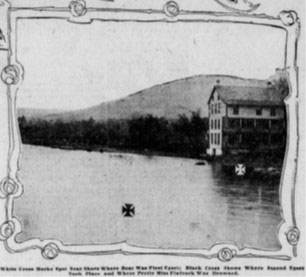
According to The San Francisco Examiner, the white cross marks the spot near the shore where the boat was first upset; the black cross shows where the second upset took place and where Miss Finnefrock was drowned.

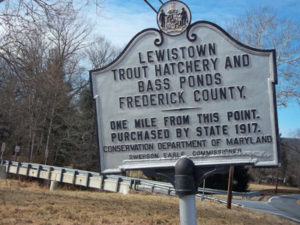 Little remains today that would suggest the size of the hatchery operation that once existed until the early 1950s. A sign on Fish Hatchery Road, off U.S. 15 south, states: “Lewistown Trout Hatchery and Bass Ponds Frederick County – Purchased by State 1917” (shown right).
Little remains today that would suggest the size of the hatchery operation that once existed until the early 1950s. A sign on Fish Hatchery Road, off U.S. 15 south, states: “Lewistown Trout Hatchery and Bass Ponds Frederick County – Purchased by State 1917” (shown right).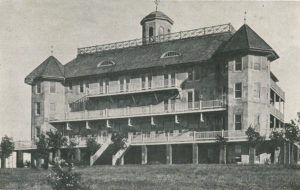
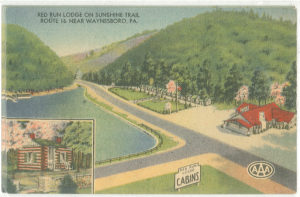 On my way to Waynesboro, Pennsylvania, last week, I noticed demolition work at the foot of Sunshine Trail. What was left of Red Run Cabins was being turned into rubble. According to an article in The Record Herald in 2005, the Red Run Lodge was built of chestnut in 1940, and cabins were added over several years. Red Run Lodge was demolished in 2005, and the cabins were left to disintegrate. I remember the lodge’s famous chicken in the basket.
On my way to Waynesboro, Pennsylvania, last week, I noticed demolition work at the foot of Sunshine Trail. What was left of Red Run Cabins was being turned into rubble. According to an article in The Record Herald in 2005, the Red Run Lodge was built of chestnut in 1940, and cabins were added over several years. Red Run Lodge was demolished in 2005, and the cabins were left to disintegrate. I remember the lodge’s famous chicken in the basket.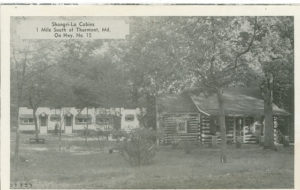 There were many other motor lodges in the area at the time. In Thurmont, Camp Cozy and Shangri-La Cabins on old Route 15 were keeping up with the times, and Barbara Fritchie Cabins and Francis Scott Key Restaurant and Motel, along Route 40 in Frederick, were catering to the tourist trade.
There were many other motor lodges in the area at the time. In Thurmont, Camp Cozy and Shangri-La Cabins on old Route 15 were keeping up with the times, and Barbara Fritchie Cabins and Francis Scott Key Restaurant and Motel, along Route 40 in Frederick, were catering to the tourist trade.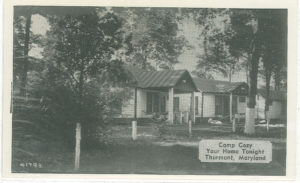 The lodge was closed in the late 1960s, and the farm continued to sell fruit at the adjoining stand until several years ago. The property was placed on the National Register of Historic Places in 1994, after being purchased by Red Run Enterprises, based in Washington, D.C., from the Smith heirs.
The lodge was closed in the late 1960s, and the farm continued to sell fruit at the adjoining stand until several years ago. The property was placed on the National Register of Historic Places in 1994, after being purchased by Red Run Enterprises, based in Washington, D.C., from the Smith heirs.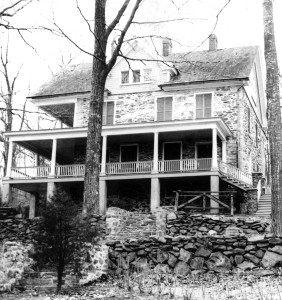 When the mail train from Baltimore stopped in Thurmont on Halloween, more than the mail was delivered. George F. Schultz, a sixty-two-year-old employee with Maryland Health Department, left the train. Schultz hired Clarence Lidie and his taxi to give him a ride to the Valley View Hotel, which was ten minutes away on the side of Catoctin Mountain.
When the mail train from Baltimore stopped in Thurmont on Halloween, more than the mail was delivered. George F. Schultz, a sixty-two-year-old employee with Maryland Health Department, left the train. Schultz hired Clarence Lidie and his taxi to give him a ride to the Valley View Hotel, which was ten minutes away on the side of Catoctin Mountain.